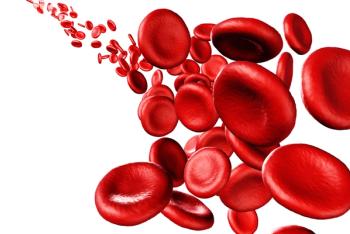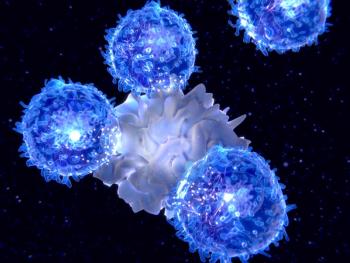
Loncastuximab Tesirine Combo Demonstrates Early Efficacy in R/R DLBCL
The safety profile of loncastuximab tesirine plus glofitamab was consistent with the known profiles of the individual agents.
Loncastuximab tesirine-lpyl (Zynlonta) plus glofitamab (Columvi) demonstrated early efficacy outcomes in a small cohort of patients with relapsed/refractory diffuse large B-cell lymphoma (DLBCL), according to a news release on findings from the dose-escalation and dose-expansion phase 1b LOTIS-7 trial (NCT04970901) from the drug’s developer, ADC Therpeutics.1
Top-line data from the trial revealed that in the efficacy-evaluable population of patients with relapsed/refractory DLBCL (n = 22), the overall response rate (ORR) was 95.5% (n = 21 of 22) and 90.9% (n = 20 of 22) of patients experienced a complete response (CR) with the combination therapy. The median duration of response (DOR) was not reached. Additionally, among 31 patients treated with the investigational regimen, the combination demonstrated a manageable safety profile.
Safety results showed that the incidence of adverse effects (AEs) was consistent with the known profiles for the individual agents. Of note, neutropenia was the most common grade 3 or higher treatment-emergent AE (TEAE), occurring in 32.3% of patients. Grade 3 or 4 TEAEs of special interest included generalized edema, pericardial effusion, photosensitivity reaction, rash, sepsis, and pneumonia, each occurring in 3.2% of patients.
Furthermore, grade 1 or 2 cytokine release syndrome (CRS) occurred in 29.0% and 9.7% of patients and grade 1 or 2 immune cell effector–associated neurotoxicity syndrome (ICANS) occurred in 0% and 6.5% of patients. No grade 3 or higher ICANS or CRS was observed as of data cutoff.
Updated data from the phase 1b trial will be presented at the
“We are excited to present the latest LOTIS-7 data from a larger subset of patients with longer follow-up at EHA and ICML,” Mohamed Zaki, MD, PhD, chief medical officer of ADC Therapeutics, said in the news release.1 “The robust efficacy and manageable safety seen to date with the combination of [loncastuximab tesirine] and glofitamab, 2 potent anticancer agents with different mechanisms of action, reinforce the potential for this regimen to change the treatment paradigm for patients with aggressive lymphoma.”
Patients in the phase 1b LOTIS-7 trial were randomly assigned to receive loncastuximab tesirine plus polatuzumab vedotin-piiq (Polivy), loncastuximab tesirine plus glofitamab, or loncastuximab tesirine plus mosunetuzumab-axgb (Lunsumio) T-cell–engaging bispecific monoclonal antibodies. Part 1 of the study encompassed a 3 + 3 dose-escalation phase in heavily pretreated patients starting with 90 µg/kg of loncastuximab tesirine and then proceeding to 120 µg/kg and then 150 µg/kg. Patients additionally received 2.5 mg of glofitamab on cycle 1, day 8; 10 mg on cycle 1, day 15; and 30 mg for day 1 of cycles 2 to 12.2
Patients treated in part 2 received the maximum tolerated dose or recommended dose for expansion of loncastuximab tesirine of either 120 µg/kg or 150 µg/kg in combination with glofitamab as well as 1000 mg of obinutuzumab pretreatment. The primary end point of the study included the safety and tolerability of loncastuximab tesirine. Secondary end points included ORR, DOR, progression-free survival, recurrence-free survival, overall survival, pharmacokinetics, and immunogenicity.
Loncastuximab tesirine is being developed as a CD19-directed antibody-drug conjugate, which, once bound to a CD19-expressing cell, is internalized. Following internalization by the cell, enzymes release a pyrrolobenzodiazepine payload, which binds to the DNA minor groove. Remaining less visible to DNA repair mechanisms, this payload facilitates cell cycle arrest and tumor cell death.
References
- ADC Therapeutics announces presentation of LOTIS-7 clinical trial data at the European Hematology Association 2025 Congress (EHA2025) and the 18th International Conference on Malignant Lymphoma (ICML). News release. ADC Therapeutics SA. May 14, 2025. Accessed May 14, 2025. https://tinyurl.com/yc7pchna
- A study to evaluate the safety and anti-cancer activity of loncastuximab tesirine in combination with other anti-cancer agents in participants with relapsed or refractory B-cell non-Hodgkin lymphoma (LOTIS-7). ClincialTrials.gov. Updated March 20, 2025. Accessed May 14, 2025. https://tinyurl.com/3wvs9cr9
Newsletter
Stay up to date on recent advances in the multidisciplinary approach to cancer.


















































































